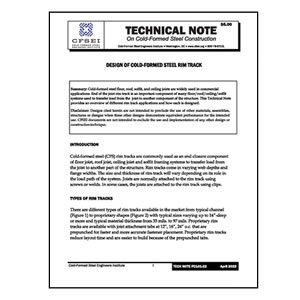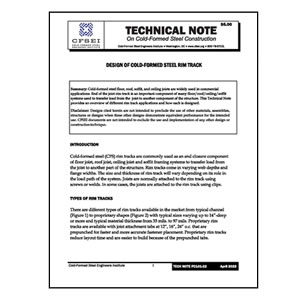Tech Note 558b-1: Lateral Load Resisting Elements: Diaphragm Design Values
$5.00
Archived with cover page Nov. 2011
Summary: This note was archived November, 2011. The author has developed ASD design tables using an analytical method for wood framing based on the provisions of the 1991 edition of the AFPA National Design Specification for Wood Construction. Additional research is needed to bring the data in line with current codes and standards. The data below is from commentary section D2.1 of American Iron and Steel Institute AISI 213, Standard for Cold-Formed Steel Framing – Lateral Design.
Disclaimer: Designs cited herein are not intended to preclude the use of other materials, assemblies, structures or designs when these other designs demonstrate equivalent performance for the intended use. CFSEI documents are not intended to exclude the use and implementation of any other design or construction technique.
Related Products

Tech Note F101-12: Screws for Cold-Formed Steel-To-Wood and Wood-To-Cold-Formed Steel Attachments
Summary: Screws are often used to attach cold-formed steel (CFS) framing to wood members or wood structural panel decking to CFS joists or rafters. The AISI North American Specification for the Design of Cold-Formed Steel Structural Members (AISI S100) provides design equations for screw connection capacity for CFS members. The National Design Specification for Wood Construction (NDS) provides design equations for fastener/connection capacity (nails, wood screws, bolts, etc.) in wood members. The Engineered Wood Association (APA) and the building codes offer several resources for determining the capacity of screw connections attaching wood sheathing. This Tech Note reviews these resources and discusses design and detailing of these fastener connections.
Disclaimer: Designs cited herein are not intended to preclude the use of other materials, assemblies, structures or designs when these other designs demonstrate equivalent performance for the intended use. CFSEI documents are not intended to exclude the use and implementation of any other design or construction technique.

Tech Note G105-22: Compression Member Reinforcement
Summary: To modify the capacity of a compression member, e.g. wall stud or truss web, adding a reinforcement may result in a non-prismatic member. This Tech Note provides guidance to evaluate the strength of a non-prismatic compression member.
Disclaimer: Designs cited herein are not intended to preclude the use of other materials, assemblies, structures or designs when these other designs demonstrate equivalent performance for the intended use. CFSEI documents are not intended to exclude the use and implementation of any other design or construction technique.

Tech Note 562-22: Powder-Actuated Fasteners in Cold-Formed Steel Construction
This Technical Note updates and replaces Tech Note 562
Summary: Power-actuated fasteners (PAF’s) are industry standard for attachment of cold-formed steel (CFS) steel framing members, usually track, to concrete, CMU or steel structural elements. “Power-actuated” is the broad category used to refer to fasteners which are driven directly through the CFS and into the substrate, using a powder, gas, compressed air or electro-mechanically driven tool. Efficient installation of framing systems is greatly enhanced by the use of PAF’s. For CFS-to-steel applications, the specification AISI S100 addresses all relevant limit states with equations and safety/ resistance factors. For CFS-to-concrete, limited guidance is provided but not all limit states are covered. This technical note will provide design guidance based on AISI S100, as well as installation and good detailing practice.
Disclaimer: Designs cited herein are not intended to preclude the use of other materials, assemblies, structures or designs when these other designs demonstrate equivalent performance for the intended use. CFSEI documents are not intended to exclude the use and implementation of any other design or construction technique.

Tech Note G801-13: ASTM A1003 – No Cause for Rejection
Summary: Building codes and design standards that reference ASTM International (ASTM) A1003 standard for cold-formed steel framing products have the potential to cause confusion and project delays for those who are unfamiliar with the requirements of this new material standard. This Technical Note, first published in 2008, provides a comparison of the requirements of A1003 with the more familiar standards traditionally used for cold-formed steel framing products, and demonstrates that steel ordered or furnished to the old standards should be no cause for rejection. The 2013 revision references a change to the requirements of ASTM A1003 regarding material thickness when ordering or supplying steel sheet.
Disclaimer: Designs cited herein are not intended to preclude the use of other materials, assemblies, structures or designs when these other designs demonstrate equivalent performance for the intended use. CFSEI documents are not intended to exclude the use and implementation of any other design or construction technique.

Tech Note 551e: Design Guide: Permanent Bracing of Cold-Formed Steel Trusses
Summary: Prefabricated and site fabricated cold-formed steel trusses have proven to be efficient and structurally-sound roof structures. While roof trusses are the major component of the structural roof system, permanent bracing is also required to complete the system and ensure that it performs as designed. In this Tech Note, the basic requirements and design parameters for permanent bracing of cold-formed steel roof systems will be reviewed.
Disclaimer: Designs cited herein are not intended to preclude the use of other materials, assemblies, structures or designs when these other designs demonstrate equivalent performance for the intended use. CFSEI documents are not intended to exclude the use and implementation of any other design or construction technique.

Tech Note FC101-22: Design of Cold-Formed Steel Rim Track
Summary: Cold-formed steel floor, roof, soffit, and ceiling joists are widely used in commercial applications. End of the joist rim track is an important component of many floor/roof/ceiling/soffit systems used to transfer load from the joist to another component of the structure. This Technical Note provides an overview of different rim track applications and how each is designed.
Disclaimer: Designs cited herein are not intended to preclude the use of other materials, assemblies, structures or designs when these other designs demonstrate equivalent performance for the intended use. CFSEI documents are not intended to exclude the use and implementation of any other design or construction technique.

Tech Note B008-20: Basic C-Shaped Wall Stud Behavior
Summary: Although cold-formed steel framing shares some limit states with hot-rolled steel, cold-formed steel framing and specifically C-Shaped studs exhibit unique behaviors when subjected to various loading conditions. This Tech Note gives an overview of those unique behaviors that need to be considered when designing C-Shaped cold-formed steel members.
Disclaimer: Designs cited herein are not intended to preclude the use of other materials, assemblies, structures or designs when these other designs demonstrate equivalent performance for the intended use. CFSEI documents are not intended to exclude the use and implementation of any other design or construction technique.

Tech Note G200-21: Chase the Loads: Load Path Considerations for Cold-Formed Steel Light-Frame Construction
This Technical Note updates and replaces CFSEI Technical Note G200-15
Summary: Engineering students are admonished to “chase the loads” in their structural analysis and design courses. A “load path” is the direction in which each consecutive load will pass through framing members and the connected members of a framing assembly. The load path sequence begins at the point of load application, both vertical (gravity, wind uplift or seismic vertical) and lateral, on the structure and works all the way down to the footing or foundation system, ultimately transferring the load of the structure to the foundation. This Tech Note provides insight into the load path considerations for cold-formed steel framing.
Disclaimer: Designs cited herein are not intended to preclude the use of other materials, assemblies, structures or designs when these other designs demonstrate equivalent performance for the intended use. CFSEI documents are not intended to exclude the use and implementation of any other design or construction technique.

